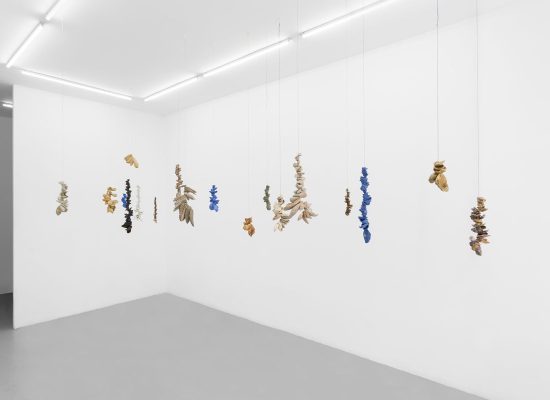Artists Joanna Piotrowska
Date 22 May – 6 July 2024
Venue Madragoa, Lisbon, Portugal
Text Sara De Chiara
Photography Bruno Lopes. Courtesy of the artist and Madragoa
In the exhibition Implicit Lives, a similar intimate dimension, achieved with elements of domestic furniture, triggers a journey through time. Black-and-white photographs depicting men and (more often) women, caught in mutual, enigmatic, and suspended gestures, analogous to the Frowst series (2013-2014), are here embedded in a domestic landscape.

Printed on fabric and installed as if it were a curtain, mounted within a soft fabric frame or framed in veneer panels that extend along the wall, or in freestanding screens that subdivide the space, the works create a continuum between the atmosphere emanating from the pictures and the actual physical space. The selected visual elements, fabric patterns, and veneer surfaces, with their vintage flavor veiled with a sense of nostalgia, can evoke to today’s adults the domestic interiors of a home they inhabited during childhood or adolescence. In particular, the mottled pattern of the veneer grain brings one back to the dimension of childhood for another reason as well.


The photographs, subjects, materials, and surfaces used by Joanna Piotrowska in the exhibition reconstruct a personal, evocative rather than objective, universe. It feels familiar and stimulates observers to project themselves into it. Everyone can recognize in it an echo of their own lived experience and the nostalgia that the past can evoke. At the same time, the photographs and the display state that it is just a reconstruction—an illusion of truth—the checkmate of any attempt to reconstitute the past, in the present time, in an unambiguous way. Recollection can only proceed by fragments, epiphanies, surfaces, by isolating details or gestures, mimicking the mechanism of memory or dreaming—moreover evoked by the closed eyes, the lying position, of the abandoned limbs of some of the portrayed figures.
The reconfiguration of a personal place—physical and metaphorical—in a montage that mimics the unpredictability and selectivity of memory is emphasized by the use of collage. On recently shot photographs, the artist superimposes fragments of photographs belonging to her family history, including details of her mother’s face. The synchronic presence of past and present characterizes collage, a technique that also eschews complete control of the self.

The self is also bracketed in the photograph depicting two brothers printed on fabric: it is the outcome of the jamming of the roll of film, which instead of running has captured the image several times in the same portion of film. Instead of in sequence, the gestures are superimposed into a single image of intangible substance, made up only of shadows. The picture with its unintentional layering falls within those perceptual phenomena invisible to the eye, but which the photographic lens is able to record thanks to what Walter Benjamin called the optical unconscious.
A phantasmagorical presence—fruit this time of collage—is also found in another photograph in which the silhouette of a female figure is replaced by her veneer outline. It seems that the woman dematerialized to teleport elsewhere, while her body was replaced by a two-dimensional surface.

A hint of this power attributed to photography (almost like an involuntary memory) echoes in the words of Susan Sontag, when in her 1977 On Photography, she stated “…a photograph is not only an image (as a painting is an image), an interpretation of the real; it is also a trace, something directly stenciled off the real, like a footprint or a death mask.”
In the exhibition, epidermis, dresses, textiles, film, veneer, and the grain of photographic paper are all layers that hold the imprint of a past. They are a number of leaflike skins that envelop the bright gem of memories and at the same time draw the perimeter of a warm physical place. Your patch for picking wild strawberries may also be there, in the hiding place behind the curtain, or among the pansies printed on a dress.




